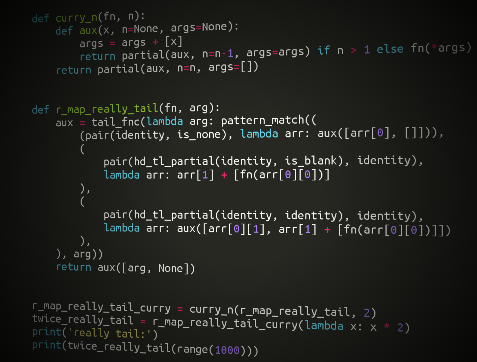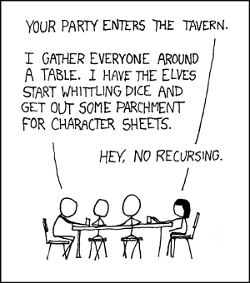Abnormal functional python programming

After reviewing the Programming Languages course and reading Functional JavaScript, I wanted to repeat all these cool things in python. Some things turned out to be done beautifully and easily, the rest came out scary and unusable.
The article includes:
- few incomprehensible words;
- currying;
- pattern matching;
- recursion (including tail).
The article is designed for python 3.3+.
')
Few incomprehensible words
In python, you can write in a functional style, because it has anonymous functions:
sum_x_y = lambda x, y: x + y print(sum_x_y(1, 2)) # 3 Higher-order functions (accepting or returning other functions):
def call_and_twice(fnc, x, y): return fnc(x, y) * 2 print(call_and_twice(sum_x_y, 3, 4)) # 14 Closures:
def closure_sum(x): fnc = lambda y: x + y return fnc sum_with_3 = closure_sum(3) print(sum_with_3(12)) # 15 Tuple unpacking (almost pattern matching):
a, b, c = [1, 2, 3] print(a, b, c) # 1 2 3 hd, *tl = range(5) print(hd, 'tl:', *tl) # 0 tl: 1 2 3 4 And cool modules of functools and itertools .
Currying
Convert a function from many arguments to a function that takes its arguments one by one.
Consider the simplest case, we curry the function
sum_x_y : sum_x_y_carry = lambda x: lambda y: sum_x_y(x, y) print(sum_x_y_carry(5)(12)) # 17 Something is not cool at all, try this:
sum_with_12 = sum_x_y_carry(12) print(sum_with_12(1), sum_with_12(12)) # 13 24 sum_with_5 = sum_x_y_carry(5) print(sum_with_5(10), sum_with_5(17)) # 15 22 Already more interesting, now let's make a universal function for currying functions with two arguments, because each time writing
lambda x: lambda y: zzzz is not at all cool: curry_2 = lambda fn: lambda x: lambda y: fn(x, y) And apply it to the
map function used in real projects: curry_map_2 = curry_2(map) @curry_map_2 def twice_or_increase(n): if n % 2 == 0: n += 1 if n % 3: n *= 2 return n print(*twice_or_increase(range(10))) # 2 2 3 3 10 10 14 14 9 9 print(*twice_or_increase(range(30))) # 2 2 3 3 10 10 14 14 9 9 22 22 26 26 15 15 34 34 38... Yes, yes, I used a curried
map as a decorator and this eliminated the lack of multi-line lambda.But not all functions take 2 arguments, so
curry_n make the function curry_n , using partial , closures and a little recursion: from functools import partial def curry_n(fn, n): def aux(x, n=None, args=None): # args = args + [x] # return partial(aux, n=n - 1, args=args) if n > 1 else fn(*args) # , aux return partial(aux, n=n, args=[]) And once again we apply to the
map , but with 3 arguments: curry_3_map = curry_n(map, 3) And we will make a function for adding list items with list items 1..10:
sum_arrays = curry_3_map(lambda x, y: x + y) sum_with_range_10 = sum_arrays(range(10)) print(*sum_with_range_10(range(100, 0, -10))) # 100 91 82 73 64 55 46 37 28 19 print(*sum_with_range_10(range(10))) # 0 2 4 6 8 10 12 14 16 18 Since
curry_2 is a special case of curry_n , you can do: curry_2 = partial(curry_n, n=2) And for example, apply it to the
filter : curry_filter = curry_2(filter) only_odd = curry_filter(lambda n: n % 2) print(*only_odd(range(10))) # 1 3 5 7 9 print(*only_odd(range(-10, 0, 1))) # -9 -7 -5 -3 -1 Pattern matching
A method for analyzing lists or other data structures for the presence of specified samples.
Pattern matching is what I liked most about sml and worst of all about python.
We will invent our goal - to write a function that:
- if it accepts a list of numbers, returns their product;
- if it accepts a list of strings, returns one large concatenated string
Create an auxiliary exception and a function for its “throwing”, which we will use when the match fails:
class NotMatch(Exception): """Not match""" def not_match(x): raise NotMatch(x) And the function that does the checking and returns the object, or throws an exception:
match = lambda check, obj: obj if check(obj) else not_match(obj) match_curry = curry_n(match, 2) Now we can create a type check:
instance_of = lambda type_: match_curry(lambda obj: isinstance(obj, type_)) Then for
int : is_int = instance_of(int) print(is_int(2)) # 2 try: is_int('str') except NotMatch: print('not int') # not int Create a type check for the list, checking its each element:
is_array_of = lambda matcher: match_curry(lambda obj: all(map(matcher, obj))) And then for
int : is_array_of_int = is_array_of(is_int) print(is_array_of_int([1, 2, 3])) # 1 2 3 try: is_array_of_int('str') except NotMatch: print('not int') # not int And now, similarly for
str : is_str = instance_of(str) is_array_of_str = is_array_of(is_str) Also add a function that returns its argument, idempotent =)
identity = lambda x: x print(identity(10)) # 10 print(identity(20)) # 20 And checking for an empty list:
is_blank = match_curry(lambda xs: len(xs) == 0) print(is_blank([])) # [] try: is_blank([1, 2, 3]) except NotMatch: print('not blank') # not blank Now we will create a function to divide the list into the first element and the remainder, applying “checks” to them:
def hd_tl(match_x, match_xs, arr): x, *xs = arr return match_x(x), match_xs(xs) hd_tl_partial = lambda match_x, match_xs: partial(hd_tl, match_x, match_xs) And consider the simplest example with
identity : hd_tl_identity = hd_tl_partial(identity, identity) print(hd_tl_identity(range(5))) # 0 [1, 2, 3, 4] And now with the numbers:
hd_tl_ints = hd_tl_partial(is_int, is_array_of_int) print(hd_tl_ints(range(2, 6))) # 2 [3, 4, 5] try: hd_tl_ints(['str', 1, 2]) except NotMatch: print('not ints') # not ints And now the function itself, which will go through all the checks. It is very simple:
def pattern_match(patterns, args): for pattern, fnc in patterns: try: return fnc(pattern(args)) except NotMatch: continue raise NotMatch(args) pattern_match_curry = curry_n(pattern_match, 2) 
But it is inconvenient to use and requires a whole world of brackets, for example, the function we need will look like this:
sum_or_multiply = pattern_match_curry(( (hd_tl_partial(identity, is_blank), lambda arr: arr[0]), # x::[] -> x (hd_tl_ints, lambda arr: arr[0] * sum_or_multiply(arr[1])), # x::xs -> x * sum_or_multiply (xs) type(x) == int (hd_tl_partial(is_str, is_array_of_str), lambda arr: arr[0] + sum_or_multiply(arr[1])), # x::xs -> x + sum_or_multiply (xs) type(x) == str )) Now let's check it in action:
print(sum_or_multiply(range(1, 10))) # 362880 print(sum_or_multiply(['a', 'b', 'c'])) # abc Hooray! It works =)
Recursion
In all cool programming languages, cool guys implement a
map through recursion, why are we worse? Moreover, we are already able to pattern matching: r_map = lambda fn, arg: pattern_match(( (hd_tl_partial(identity, is_blank), lambda arr: [fn(arr[0])]), # x::[] -> fn(x) ( hd_tl_partial(identity, identity), lambda arr: [fn(arr[0])] + r_map(fn, arr[1]) # x::xs -> fn(x)::r_map(fn, xs) ), ), arg) print(r_map(lambda x: x**2, range(10))) # [0, 1, 4, 9, 16, 25, 36, 49, 64, 81] Now we curry:
r_map_curry = curry_n(r_map, 2) twice = r_map_curry(lambda x: x * 2) print(twice(range(10))) # [0, 2, 4, 6, 8, 10, 12, 14, 16, 18] try: print(twice(range(1000))) except RuntimeError as e: print(e) # maximum recursion depth exceeded in comparison Something went wrong, try tail recursion.
To do this, create a "check" on
None : is_none = match_curry(lambda obj: obj is None) And checking the pair:
pair = lambda match_x, match_y: lambda arr: (match_x(arr[0]), match_y(arr[1])) And now the
map itself: def r_map_tail(fn, arg): aux = lambda arg: pattern_match(( (pair(identity, is_none), lambda arr: aux([arr[0], []])), # None, [] ( pair(hd_tl_partial(identity, is_blank), identity), lambda arr: arr[1] + [fn(arr[0][0])] # (x::[], acc), fn(x) ), ( pair(hd_tl_partial(identity, identity), identity), lambda arr: aux([arr[0][1], arr[1] + [fn(arr[0][0])]]) # (x::xs, acc), xs + fn(x) ), ), arg) return aux([arg, None]) Now let's try our miracle:
r_map_tail_curry = curry_n(r_map_tail, 2) twice_tail = r_map_tail_curry(lambda x: x * 2) print(twice_tail(range(10))) # [0, 2, 4, 6, 8, 10, 12, 14, 16, 18] try: print(twice_tail(range(10000))) except RuntimeError as e: print(e) # maximum recursion depth exceeded That's bad luck - python does not optimize tail recursion. But now crutches will come to our aid:
def tail_fnc(fn): called = False calls = [] def run(): while len(calls): # res = fn(*calls.pop()) return res def call(*args): nonlocal called calls.append(args) # if not called: # , - called = True return run() return call Now we implement with this
map : def r_map_really_tail(fn, arg): aux = tail_fnc(lambda arg: pattern_match(( # (pair(identity, is_none), lambda arr: aux([arr[0], []])), # None, [] ( pair(hd_tl_partial(identity, is_blank), identity), lambda arr: arr[1] + [fn(arr[0][0])] # (x::[], acc), fn(x) ), ( pair(hd_tl_partial(identity, identity), identity), lambda arr: aux([arr[0][1], arr[1] + [fn(arr[0][0])]]) # (x::xs, acc), xs + fn(x) ), ), arg)) return aux([arg, None]) r_map_really_tail_curry = curry_n(r_map_really_tail, 2) twice_really_tail = r_map_really_tail_curry(lambda x: x * 2) print(twice_really_tail(range(1000))) # [0, 2, 4, 6, 8, 10, 12, 14, 16, 18... Now it worked =)
Not so scary
 If we forget about our awful pattern matching, then the recursive
If we forget about our awful pattern matching, then the recursive map can be implemented quite neatly: def tail_r_map(fn, arr_): @tail_fnc def aux(arr, acc=None): x, *xs = arr if xs: return aux(xs, acc + [fn(x)]) else: return acc + [fn(x)] return aux(arr_, []) curry_tail_r_map = curry_2(tail_r_map) And we will make on it multiplication of all odd numbers in the list by 2:
@curry_tail_r_map def twice_if_odd(x): if x % 2 == 0: return x * 2 else: return x print(twice_if_odd(range(10000))) # [0, 1, 4, 3, 8, 5, 12, 7, 16, 9, 20, 11, 24, 13, 28, 15, 32, 17, 36, 19... It turned out quite neatly, albeit slowly and unnecessarily. At least because of the speed. Compare the performance of different
map options: from time import time checker = lambda x: x ** 2 + x limit = 10000 start = time() xs = [checker(x) for x in range(limit)][::-1] print('inline for:', time() - start) start = time() xs = list(map(checker, range(limit)))[::-1] print('map:', time() - start) calculate = curry_tail_r_map(checker) start = time() xs = calculate(range(limit))[::-1] print('r_map without pattern matching:', time() - start) calculate = r_map_really_tail_curry(checker) start = time() xs = calculate(range(limit))[::-1] print('r_map with pattern matching:', time() - start) Then get:
inline for: 0.011110067367553711
map: 0.011012554168701172
r_map without pattern matching: 3.7527310848236084
r_map with pattern matching: 5.926968812942505
The pattern matching option was the slowest, and the built-in map and for were the fastest.
Conclusion
From this article in real applications you can only use currying. The rest is either unreadable or brake bike =)
All examples are available on github.
Source: https://habr.com/ru/post/193920/
All Articles